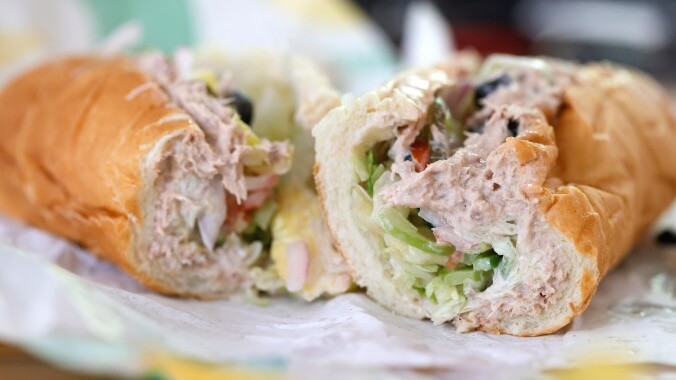Read this: Those harrowing tales of Subway's mystery tuna sandwich might be greatly exaggerated
Sure, the lab results aren't really helping their case but... there's no cause for alarm

Earlier this year, fast food sandwich chain Subway was hit with a class-action lawsuit in California, which claims that the “tuna” mixture present in their classic foot-long is “completely bereft of tuna as an ingredient.” What a horrifying sentence, especially when considering Subway’s role as the largest sandwich chain in the world; they dole out this concoction on a daily basis.
Since the lawsuit, Subways has consistently denied the claims.
“There simply is no truth to the allegations in the complaint that was filed in California,” a spokeswoman tells The New York Times. “Subway delivers 100 percent cooked tuna to its restaurants, which is mixed with mayonnaise and used in freshly made sandwiches, wraps and salads that are served to and enjoyed by our guests.”
Eager for the truth, Julia Carmel at The New York Times took it upon herself to take a “deep dive” into how canned tuna in the states is processed, sending five tuna sandwiches from Subway in for lab testing. Carmel purchased the sandwiches from three different Subway locations in Los Angeles, removed tuna and mayo mixture from the sandwich, and stored it to plastic Ziploc bags before sending it off to a lab.
According to the Food and Drug Administration, there are 15 species of nomadic saltwater fish that can be considered “tuna.” Subways claims its tuna is specifically skipjack and yellow tuna. The lab results?
“No amplifiable tuna DNA was present in the sample and so we obtained no amplification products from the DNA,” the email from the unnamed lab reads. “Therefore, we cannot identify the species.”
However, there’s a couple of possible explanations for the results. “There’s two conclusions,” a spokesperson from the lab says. “One, it’s so heavily processed that whatever we could pull out, we couldn’t make an identification. Or we got some and there’s just nothing there that’s tuna.”
So, is Subway’s tuna just over-processed and over-cooked, or is it anything but the saltwater fish? In February, Insider Edition sent their own samples off to a lab and found that it was in fact tuna.
It could be tricky to figure out the if Subway’s tuna is the real deal because once the product is cooked, its DNA denatures change, making it impossible to identify. Additionally, the problem could go deeper than the product leaving Subway’s doors, with potential fraud happening at canneries, or mislabeling of fish by fishmongers.
Aside from all of the fishy lab results, there’s another portion of the NYT piece that should make make diners’ ears perk up: Carmel also talked with different Subway sandwich artists, including a manager of a shop in California named Sage. The two went over what happens to the tuna after it arrives at the shop and general procedure for storage and maintenance, including the little detail that the prepped tuna can stay on the refrigerated sandwich bar for up to 72 hours. If that sounds like a long time for canned tuna to sit in a hopefully at-temperature fridge, you’re not alone. Even the manager Sage says, “We all agree—all of us that work there—it gets kind of gross.” Do what you will with this information.